
Today's fabrics come from a variety of sources--different animals, plants, minerals or artificial processes--sources which can be grouped into two basic categories: natural and synthetic. Most of the time, we wear one, the other or a combination of both types of fabric without noticing the difference, but in certain situations, it's good to know your fabrics.
Natural Clothes
Natural clothes are clothes made of fabrics from material that occurs in nature: wools, hair, fur or silk from animals, or threads made from plants like cotton and hemp. Leather is also considered a natural fabric.
Synthetic Clothes
Synthetic clothes are clothes made from fabric that is the result of a chemical process. Synthetic polymers are woven into fibers which are then used to weave the synthetic cloth. Clothing made from these fabrics include nylon stockings and spandex shorts, as well as the iconic polyester leisure suit.
Biodegradeability
One of the major differences between the two types of clothing is how long the fabric lasts. Unless the natural clothing is treated with some kind of preservative, it will disintegrate and decompose over several years. On the other hand synthetic clothes tend to last longer. As an example, it takes nylon up to 40 years to decompose in a landfill.
Flammability
Unless treated with flame retardant, synthetic clothes are relatively more flammable than natural clothes. Both types of clothes burn, and the rate of burn largely depends on the density of the material, but a synthetic material like acrylic, for instance, will burn faster than wool. Additionally, synthetic clothing may melt and meld to the wearer, causing more damage than the flames alone.
Performance
When considering factors like extreme weather or temperatures or athletic exertion, synthetic clothes have the advantage of materials that can be engineered specific to their purpose. Thus, popular waterproof, weatherproof clothing that is light, durable and dries fast tends to be made of some kind of synthetic fiber.
Natural fibers on the other hand, can vary in their effectiveness outdoors, although some of the higher end clothing can be just as, or even more effective than its synthetic counterparts.
Style
It's a largely subjective notion, but natural fibers are often associated with better quality clothing and a more sophisticated style. The wool suit, for instance, is seen as a classic while the polyester suit is often seen as tacky. As style and fabrics evolve, with synthetics and synthetic blends coming closer to the look and feel of natural fabrics, the gap will likely narrow.
Related Articles

The Advantages of Wool Clothing

Which Fabrics Are Most Fire Resistant?

Wool Vs. Polyester Suits

Microfiber vs. Cotton Clothes

What Is the Difference Between Acrylic ...

Advantages and Disadvantages of ...

Twill vs a Cotton-Polyester Blend

Advantages & Disadvantages of Natural ...

What Is Arnel Vintage Material Fabric?

What Types of Fabrics Absorb Dye Best?

Nylon vs. Cotton Panties

Care of Mohair Fabric

Characteristics of Polyester & Cotton

The Differences Between Fleece & ...

What Is the Difference Between Lycra ...

Winter Clothes Materials

Nomex Vs. Indura Cotton

Characteristics of Rayon Fabric

What Are Fire Resistant Clothes Made Of?

Polyester Vs. Cotton Socks
References
Writer Bio
Sonia Fernandez is a writer living in Santa Barbara, California. Her background is primarily in news, as a general assignment reporter for a local news website, but she also does the occasional magazine feature, Web article, short story or travel piece. She holds a Bachelor of Arts in English from the University of California, Santa Barbara.
Photo Credits
clothes shop image by Radu Razvan from Fotolia.com